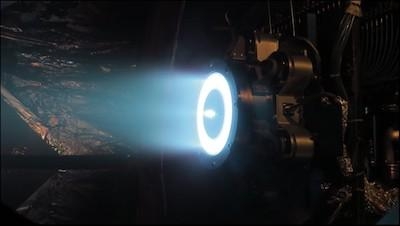Thu, Nov 14, 2019
Full Power Demonstration Conducted On The Hall Thruster
NASA and Aerojet Rocketdyne recently demonstrated an Advanced Electric Propulsion System (AEPS) thruster at full power for the first time, achieving an important program milestone. Aerojet Rocketdyne-developed AEPS thrusters are slated to be used on the Power and Propulsion Element of NASA’s Gateway, the agency’s orbiting lunar outpost for robotic and human exploration operations in deep space.

The state-of-the-art AEPS Hall thruster operated at 12.5 kilowatts (kW) as part of its final conditioning sequence during testing at the Jet Propulsion Laboratory in Pasadena, California. The thruster demonstrated stable operation at power levels ranging from 4.2 kW to 12.5 kW. Full electric propulsion thruster string integration will take place early next year.
“Our AEPS thruster has demonstrated the high levels of power needed to operate the Power and Propulsion Element, and by extension, the entire Gateway,” said Aerojet Rocketdyne CEO and President Eileen Drake. “With a successful full power test complete, Aerojet Rocketdyne is ready for the next phase of our advanced electric propulsion system in support of NASA’s Artemis program.”
The Gateway’s Power and Propulsion Element is a high-power solar electric propulsion spacecraft capable of producing 60 kW – which is three times more powerful than current capabilities. Two Aerojet Rocketdyne AEPS thruster strings will be employed on the spacecraft. Each string is comprised of a Xenon Hall thruster, a power processing unit that controls the electric power to the thruster, and a Xenon flow controller which controls the flow of Xenon to the thruster.
The AEPS thruster is part of a larger Aerojet Rocketdyne AEPS development effort under contract with NASA’s Glenn Research Center. Early system integration tests for AEPS were successfully conducted last August, proving the system’s ability to successfully convert power at a high efficiency level, producing minimal waste heat. NASA aims to launch the Power and Propulsion Element in late 2022 in support of the Artemis program, which will land the first woman and next man on the Moon by 2024.
(Image provided with Aerojet Rocketdyne news release)
More News
Aero Linx: Model Aeronautical Association of Australia MAAA clubs are about fun flying, camaraderie and community. For over 75 years, the MAAA has been Australia’s largest fl>[...]
Touchdown Zone Lighting Two rows of transverse light bars located symmetrically about the runway centerline normally at 100 foot intervals. The basic system extends 3,000 feet alon>[...]
“Discovery and innovation are central to our mission at Virgin Galactic. We’re excited to build on our successful record of facilitating scientific experiments in subor>[...]
How To Get A Story On Aero-TV News/Feature Programming How do I submit a story idea or lead to Aero-TV? If you would like to submit a story idea or lead, please contact Jim Campbel>[...]
Student Pilot Reported That During Rotation, “All Of A Sudden The Back Of The Plane Kicked To The Right..." Analysis: The student pilot reported that during rotation, “>[...]
 ANN's Daily Aero-Linx (05.02.24)
ANN's Daily Aero-Linx (05.02.24) ANN's Daily Aero-Term (05.02.24): Touchdown Zone Lighting
ANN's Daily Aero-Term (05.02.24): Touchdown Zone Lighting Aero-News: Quote of the Day (05.02.24)
Aero-News: Quote of the Day (05.02.24) ANN FAQ: Contributing To Aero-TV
ANN FAQ: Contributing To Aero-TV NTSB Final Report: Cirrus Design Corp SR20
NTSB Final Report: Cirrus Design Corp SR20



